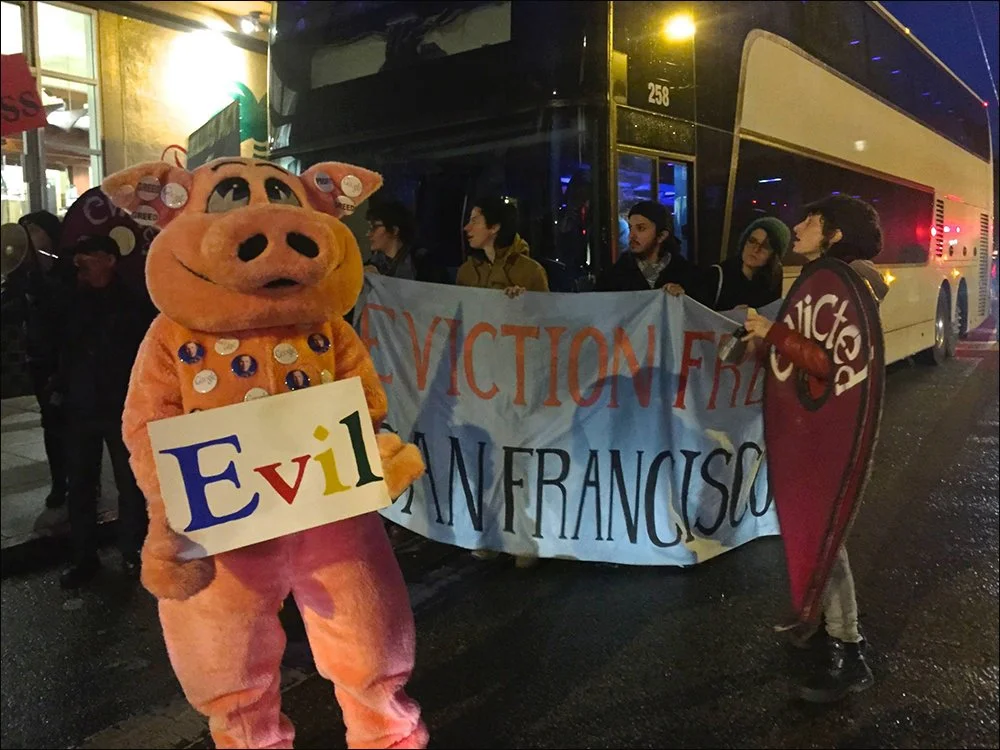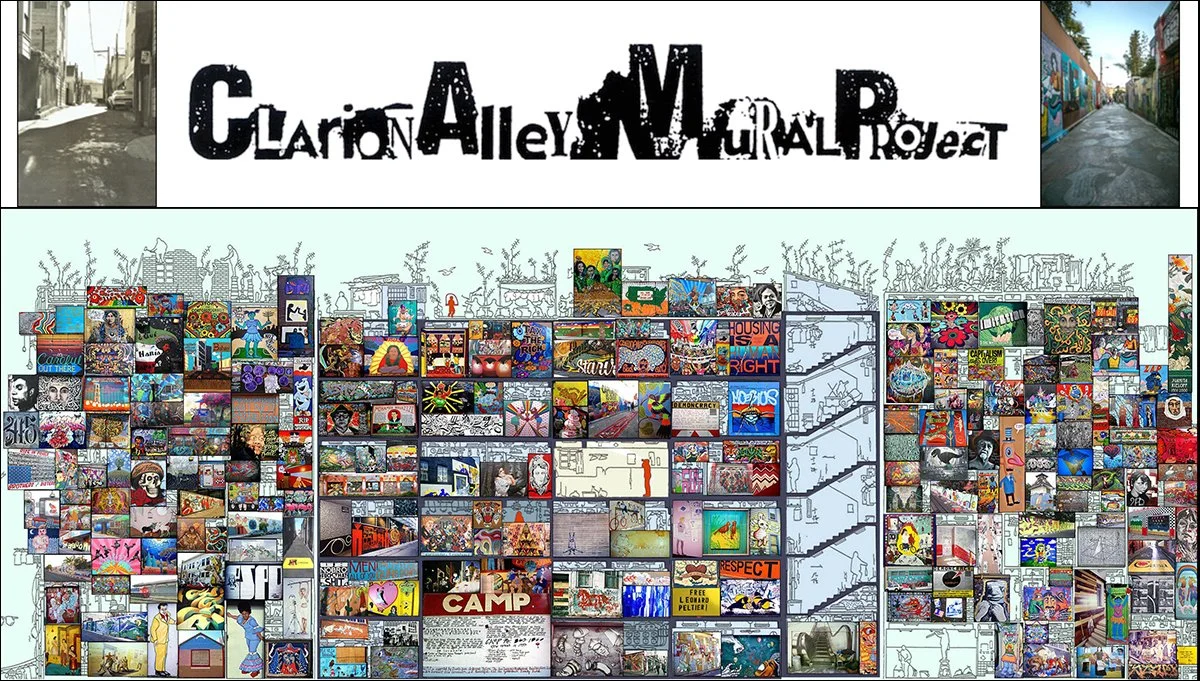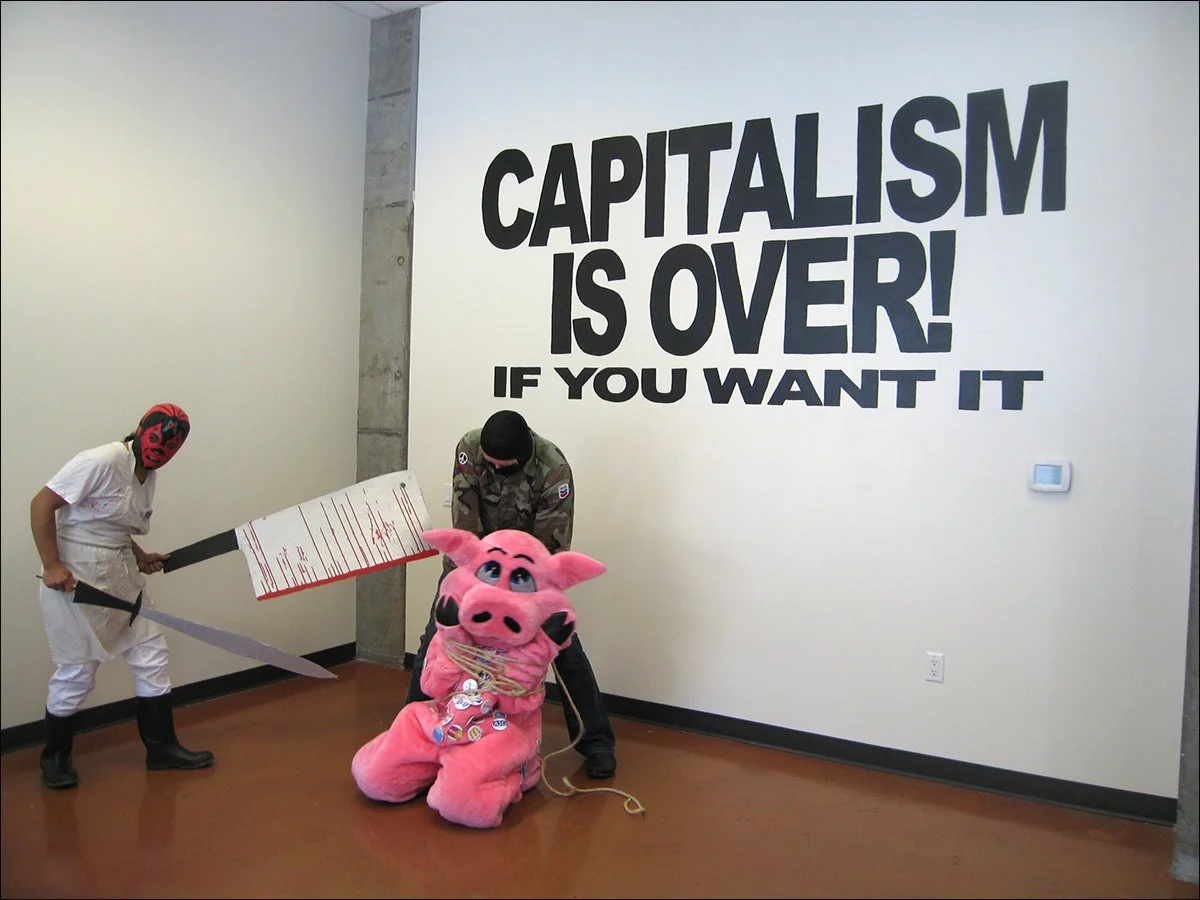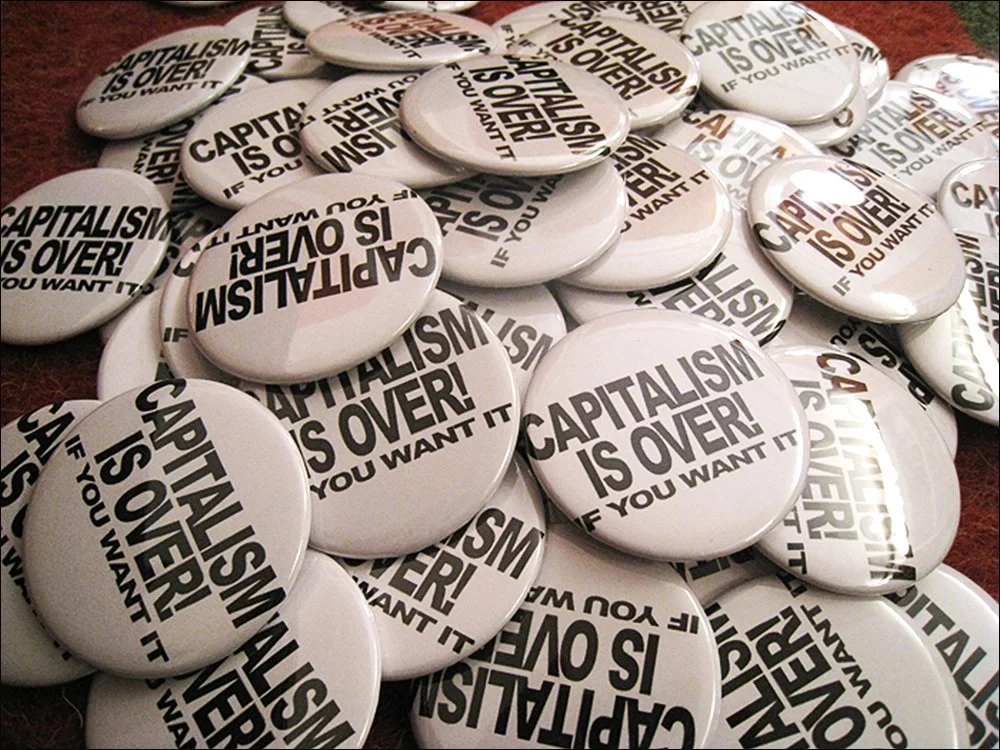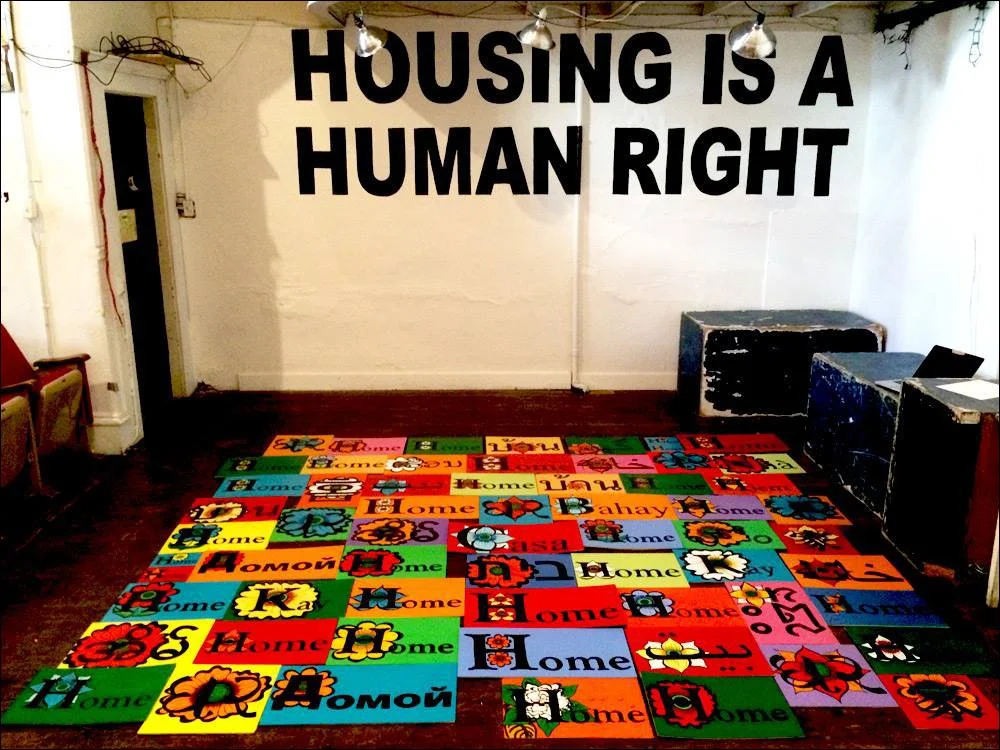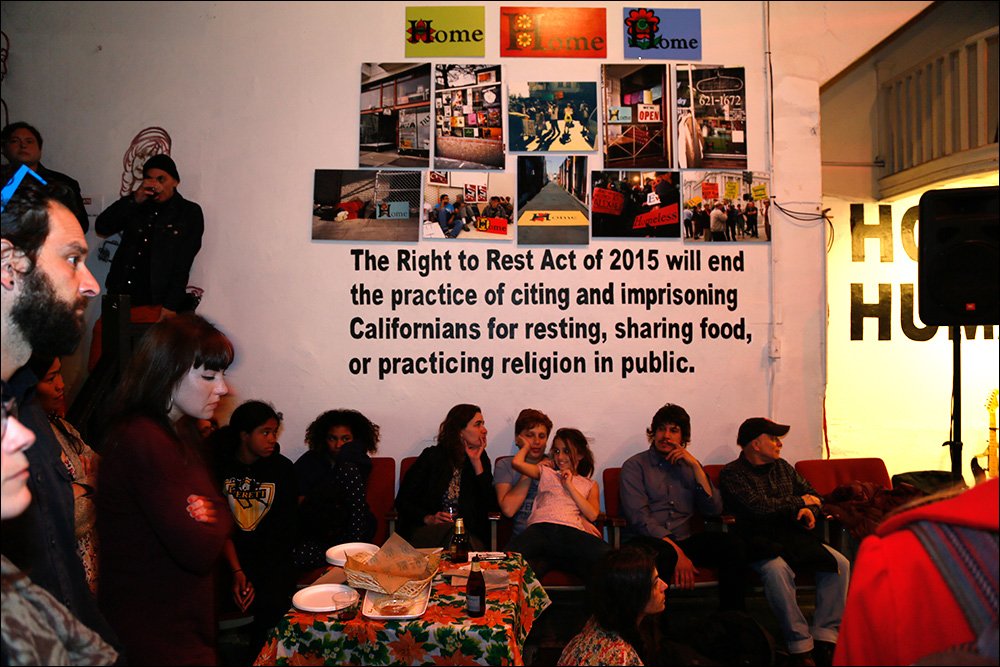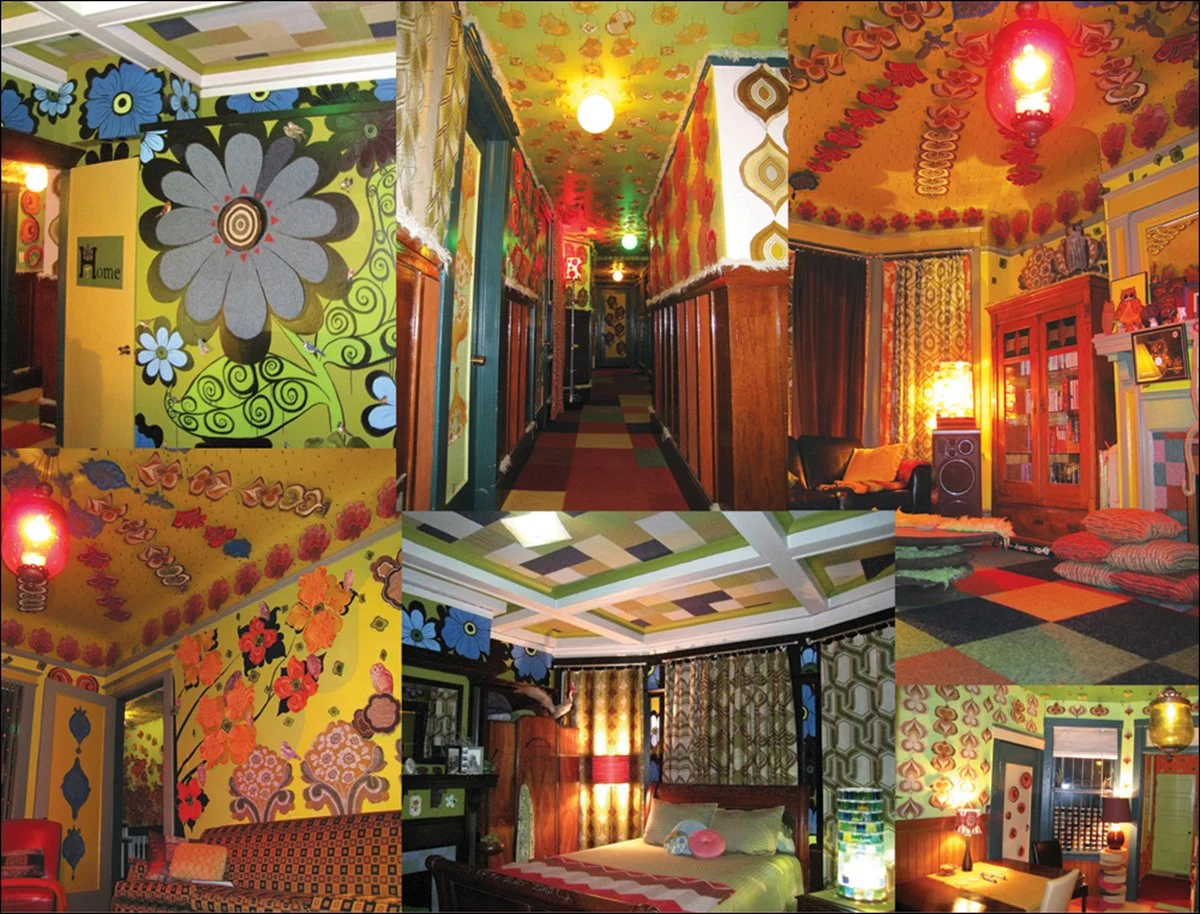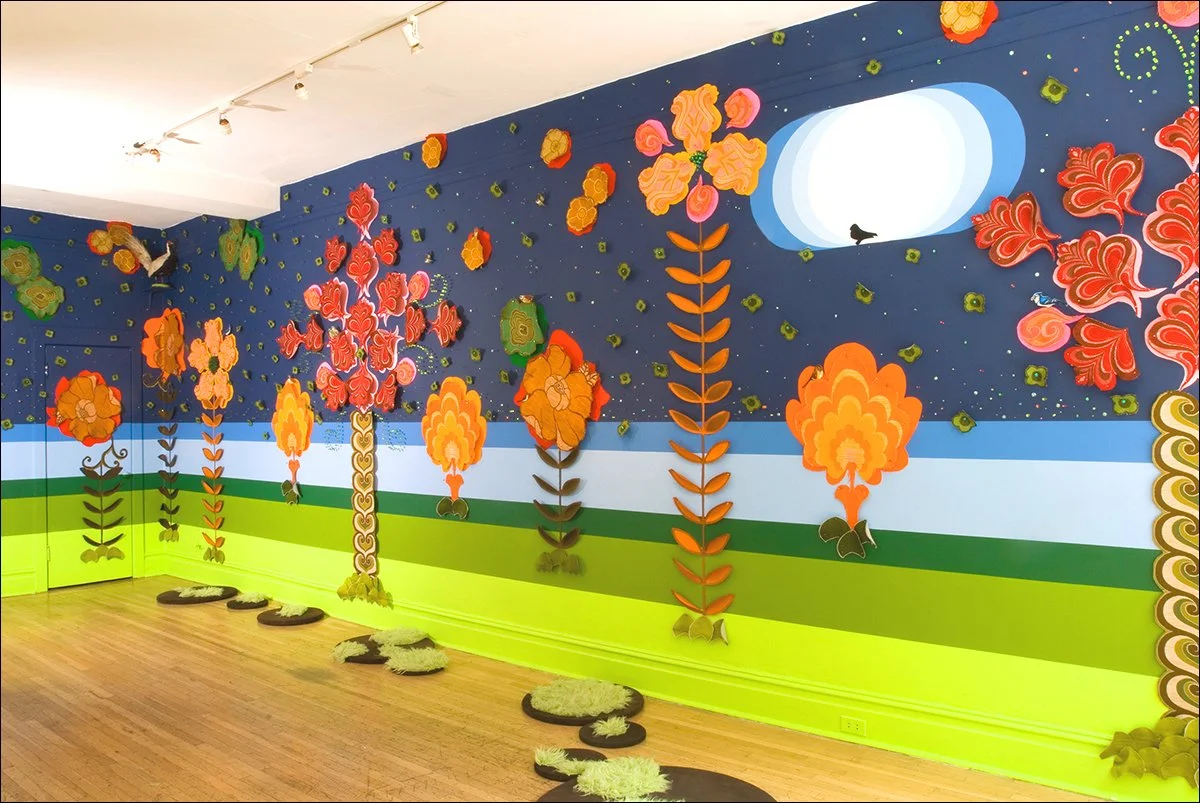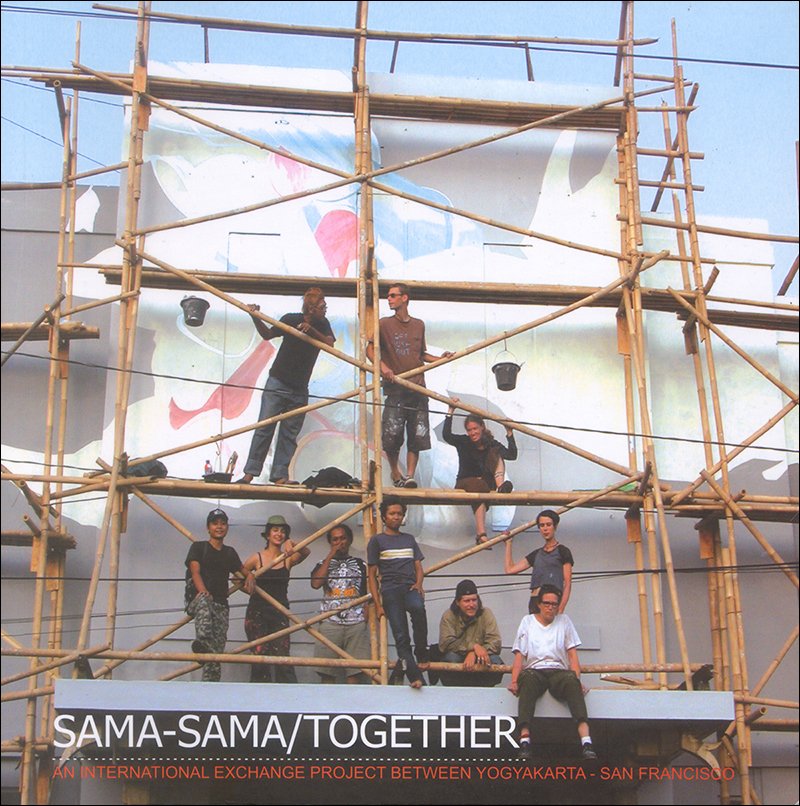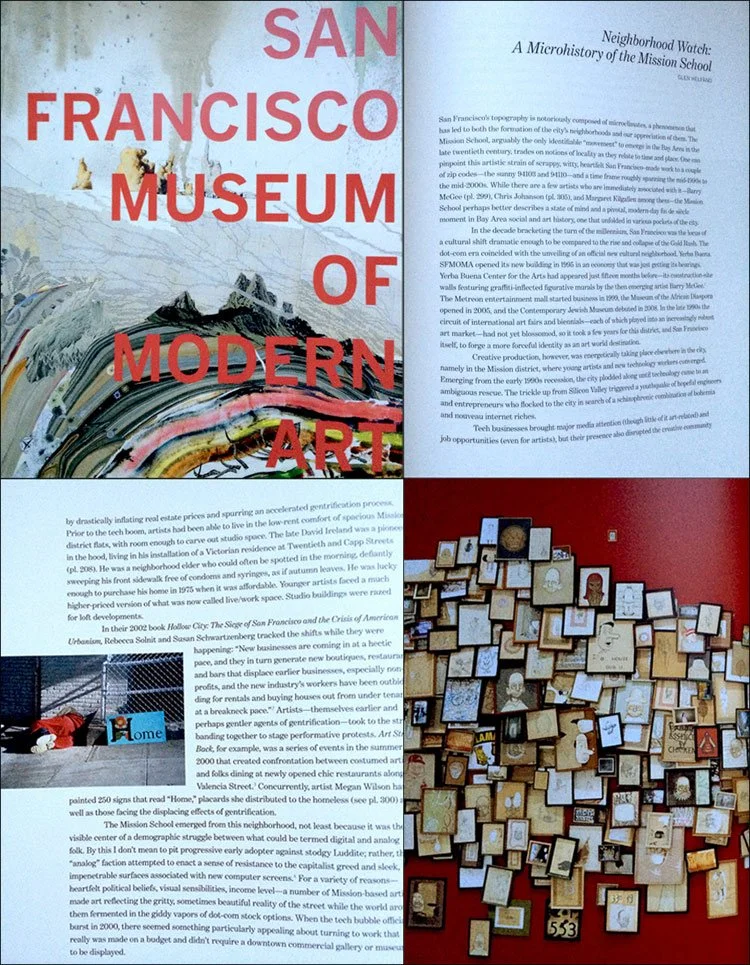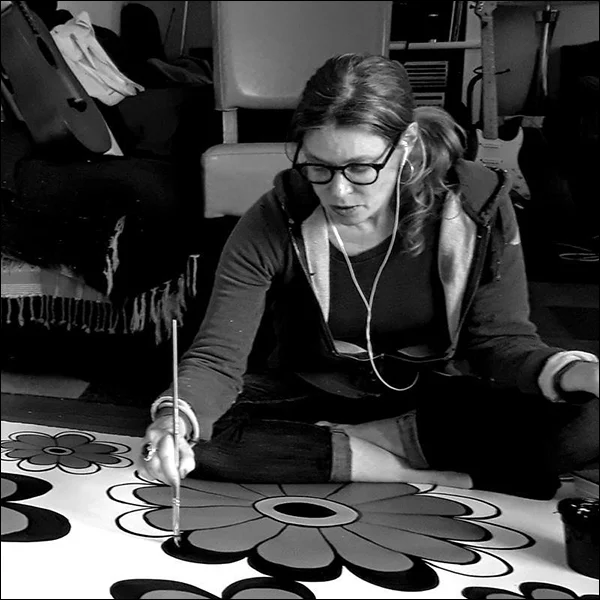About the Artist
Megan Wilson is an artist, writer, and activist based out of San Francisco.
Megan Wilson, Flower Interruption, installation at the Asian Art Museum, 2017, photo by Erin Feller
Megan Wilson creates large-scale projects utilizing a broad range of methodologies and aesthetics as a point of entry and engagement for the subjects she addresses conceptually.
Wilson has used murals, street art, performance, poster prints, and video projections as a form of social/political messaging; she’s used traditional crafts, interior design, and sign painting to explore the meanings of “home” and “homelessness;” and her social practice work includes Clarion Alley Mural Project, Bangkit/Arise and Sama-Sama/Together, international exchange and residencies between artists and communities in the San Francisco Bay Area and Yogyakarta, Indonesia, her Flower Interruptions, Better Homes & Gardens Today, Capitalism Is Over if You Want It, Bikes, Becaks, and Art Strike’s Back.
In addition to the United States, Megan has created public projects using a social practice framework in cities/countries that include: Bali, Indonesia; Tokyo, Japan; Yogyakarta, Indonesia; Jaipur, India; and Manila, Philippines.
Tax the Rich, mural, Clarion Alley Mural Project, San Francisco, CA, 13’ x 13.5’, 2013
MURALS & STREET ART AS A STRATEGY FOR SOCIAL / POLITICAL MESSAGING
Since 2000 - present Megan Wilson has used public murals and street art as a strategy for reaching large audiences to deliver social/political messaging. Wilson often uses beauty/design and a pop sensibility to capture the attention of viewers, placing the works in highly visible/trafficked areas, (e.g. Clarion Alley Mural Project in San Francisco receives over 200,000 visitors annually), as well as through social media and publications that use Wilson’s work.
Wilson’s Piggy supporting an anti-Google bus action with the Anti-Eviction Mapping Project
INTERNATIONAL EXCHANGE PROJECTS WITH YOGYAKARTA, INDONESIA: SAMA-SAMA/TOGETHER (2003), GENENG STREET ART PROJECT #3 (2015), and BANGKIT/ARISE (2018 - 2022)
In 2003 as director of Clarion Alley Mural Project (CAMP) Wilson curated and co-organized with Kevin Chen/Intersection for the Arts and Ade Tanesia/Apotik Komik, the international exchange and residency Sama-sama/Together, a collaboration between community arts organizations and artists from San Francisco (USA) and Yogyakarta (Indonesia) designed to foster understanding of Muslim and non-Muslim cultures following 9/11.
In 2015 Wilson participated with CAMP co-director Christopher Statton in the Geneng Street Art Project #3 in Yogyakarta
In 2018 she co-curated, co-directed and co-organized (with Christopher Statton and Nano Warsono CAMP's second international exchange and residency project, Bangkit /Arise between artists from Yogyakarta and San Francisco/Bay Area in collaboration with the Asian Art Museum of San Francisco and Allison Wyckoff, Associate Director, Public + Community Programs. The second phase of the residency was scheduled to take place in 2020/21. However, due to the global Covid-19 pandemic, project participants connected through online meetups throughout 2020-22 and presented the online exhibition Bangkit Sama-Sama/Together We Rise in April - June 2021. The book documenting the 2018 Residency Bangkit/Arise Solidaritas! is scheduled to be published in 2023, underwritten by the Asian Art Museum of San Francisco.
Urip Iku Urup, 440 Jalan Bantul, Panggungharjo, Yogyakarta, Indonesia, 23’ x 10’, 2018
CLARION ALLEY MURAL PROJECT
Wilson has been a core organizer of Clarion Alley Mural Project (CAMP) since 1998 and co-director 2001-2005 and 2010 - present, operating as a social practice project of Wilson’s.
The Mission of Clarion Alley Mural Project (CAMP) is to support and produce socially-engaged and aesthetically innovative public art, locally and globally, as a grassroots community-directed organization based in San Francisco’s Mission District. CAMP is a diverse and inclusive community, a public space, and an organizing force that uses murals and street art as a means for supporting social justice messaging.
Throughout its history Clarion Alley Mural Project (CAMP) has used public art as a force for those who are marginalized and a place where culture and dignity speak louder than the rules of private property or a lifestyle that puts profit before compassion, respect, and social justice.
Opening celebration for In Honor Of …, curated by Shaghayegh Cyrous, calling attention to prisoners of conscience and human rights abuses in Iran, Clarion Alley, 2019
CAPITALISM IS OVER! If You Want It Lunch-In performance, San Francisco, CA, July 2010
CAPITALISM IS OVER! IF YOU WANT IT
Wilson is a core organizer of CAPITALISM IS OVER! If You Want It, a project she co-founded with Cheryl Meeker, Amy Berk, Andy Cox, Eliza Barrios, and Maw Shein Win in 2010. CAPITALISM IS OVER! is an ongoing movement of interruptions/actions by artists from around the world in response to the need for a fundamental shift in our approach to Capitalism and the negative impact it has on the environment, health, and wellbeing of all. The status quo is not sustainable. The title of the project references John and Yoko’s “War is Over if You Want It” campaign of the late ’60′s – in the spirit that capitalism is our war of today. The title also reflects how these phenomena are based in our minds and rely on our buy-in to function. Capitalism is not a law of nature. Humans created the system, it no longer works for the majority of the world, and it can be replaced.
Better Homes and Gardens Today, ATA, San Francisco, CA 2015
BETTER HOMES & GARDENS TODAY
In 2000 Megan Wilson hand painted 250 signs that read “Home” for her project Better Homes and Gardens for which she distributed them to residents living on the streets and those in danger of eviction to place in their carts or windows as a sign of solidarity during a period in which evictions were skyrocketing in San Francisco. Better Homes & Gardens Today is an outgrowth of that project with Christopher Statton.
Better Homes & Gardens Today is a social practice project by Megan Wilson and Christopher Statton developed to:
1) Heighten awareness around “home” and the realities of homelessness;
2) Cultivate a dialog within communities and amongst disparate groups about housing instability; and
3) To raise money to benefit The Gubbio Project, the Coalition On Homelessness, and At The Crossroads, organizations working to address homelessness in San Francisco.
Wilson and Statton are creating a limited edition of 300 pairs of hand-painted “Home” signs. The single word for “Home” is painted in black in different languages against a color background and with a flower. The signs are painted on 1⁄4" plywood and range in size from 12"x18" to 16"x30."
For more information about the project, please visit:
www.BetterHomesAndGardensToday.org
All people, especially those who are living on the streets or have mental health or substance abuse issues, are worthy of respect, dignity, and loving kindness.
Better Homes and Gardens Today, ATA, San Francisco, CA 2015
Better Homes and Gardens Today, San Francisco, CA 2015, thank you Margaret Cho for your support!
Flower Interruption: Civic Center Commons, Asian Art Museum, San Francisco, CA, installation, 2017
FLOWER INTERRUPTIONS
Megan Wilson’s Flower Interruptions are a playful response to the monotony of the predictable and day-to-day routine. Through these installations Wilson aims to create an unexpected environment of joy and delight for viewers/ participants.
Wilson began this body of work in 2002 and has created projects in Indonesia, Japan, Philippines, India, and the Bay Area. Her latest project in 2017 was a multi-faceted social practice work in collaboration with the Asian Art Museum (AAM) of San Francisco.
To learn more about the Flower Interruption project with the AAM and other Interruptions, visit the website:
www.FlowerInterruption.com
Flower Interruption: San Francisco - Intersection of Market/McAllister and Jones Streets, performance and installation, 2003
Home 1996 - 2008, Installation, San Francisco, CA, 2004 - 2008
HOME 1996-2008
From 2004 – 2008 Wilson transformed her 1,600 sq. ft. living space into an installation that explored and challenged the meanings of “home” and “homelessness” through her project Home 1996-2008.
Home 1996-2008: Living Room & Office
Home 1996 - 2008: Hallway & Kitchen
Home 1996 - 2008: Bedroom & Bathrooms
Home 1996-2008: Dinner Salons
Home 1996-2008: Curated Events
Home 1996-2008: Projections
Home 1996-2008: De-Install
Home 1996 – 2008 was a site-specific installation/environment that utilized the interior space of Wilson’s home to explore and challenge notions of comfort and protection, private and public, and the boundaries between art/life/architecture/ design. The title is a bit of misnomer because Wilson began working on the project in 2004 (the dates reflect the years that she lived at the residence). In 2008 Wilson and all tenants in the building were served with an Ellis Eviction (the eviction had nothing to do with the installation - you can read more about the project in an essay Wilson wrote for Art Practical HERE.
Megan Wilson, Home 1996 - 2008, synecdoche at home! curated by Maw Shein Win, 2008
Night Bloom, installation (paint, textiles -- cut curtains from the sixties and seventies, felt, pins, floor pieces -- plywood and suede, carpet), 29' x 11', Meridian Gallery, San Francisco, CA, 2006
INTERIORS
While not as well-known as her public projects, Wilson’s more personal “interior” works are a core part of her practice as an artist.
Growing up in Montana in the seventies and eighties, Wilson was deeply inspired by the beauty of its majestic landscape - the colors, the mountains, the forests, the rivers, the wildflowers. Wilson’s mother was also a strong influence on her daughter - as an artist herself, and as someone who loved to work with design, and decoration in her approach to everything.
It is also critical for Wilson to take breaks away from her public socio-political and social practice projects to reflect and re-energize by creating work that “draws from my personal and aesthetic interests and allows me space to be more playful, experimental, and contemplative. And sometimes these spaces are integrated and work together.”
The Grass Is Always Greener, installation (paint, textiles -- cut curtains from the sixties and seventies, suede, quilling, pins, blue astroturf), Sun Valley Art Museum, Sun Valley, Idaho, 2009
Red Lodge Drawing #3, gouache, quilling (paper craft), 22" x 30," 2011
Quillling
Quilling involves rolling, scrolling and fluting narrow strips of paper into intricate shapes with a needle, specifically designed for the craft. Quilling (also known as paper filigree) was originated over five hundred years ago by members of the European religious orders. Most of the quillwork now in museums dates from the eighteenth or nineteenth century in England. There, quilling was considered to be an appropriate hobby for the fashionable ladies of the time. As well as baskets, other everyday items were elaborately decorated with quillwork: tea caddies of various shapes and sizes, trays, fire screens, and furniture. Paper filigree pictures were also popular; coats of arms and floral designs were favorite themes. Quilling spread from England to the American colonies, where it found a home in the New England area and then made its way out to the West. Quilling’s popularity faded during the late 1800’s, made a reappearance in the forties and fifties, and since the early 2000’s has again become a popular craft, as well as a fine art medium.
Wilson began quilling as a child when her grandmother passed the fashionable craft of her childhood on to her granddaughter. In 1997, she began creating drawings using quilling, later moving from outside the frame and expanding onto the walls of galleries and museums.
The Irresistible Terror of Loveliness, quilling (paper), 38,000 pins, Installation at Southern Exposure Gallery, San Francisco, 61’ x 12’, 2001
Detail: The Irresistible Terror of Loveliness, quilling (paper), 38,000 pins, Installation at Southern Exposure Gallery, San Francisco, 61’ x 12’, 2001
ART STRIKE’S BACK (2000): RESPONSE TO THE GENTRIFICATION AND DISPLACEMENT IN THE SAN FRANCISCO BAY AREA AS A RESULT OF THE DOTCOM BOOM
In 2000 Wilson co-organized the performance/protest series Art Strikes Back with Lise Swenson, and Tim Costigan that included over 70 artists. Art Strike's Back was one response to the unprecedented and unrestricted level of gentrification and displacement that we experienced in San Francisco during the "dotcom boom", impacting individual residents, small businesses, and non-profit organizations.
“We are in the eye of one of the most intense and thorough-going storms of acquisition and consolidation of wealth and power in history, one that is leaving a larger share of humanity out of it's benefits while expanding it's exploitive capabilities over them, and is able, at the very same moment, to tell the world with a straight face that it is about empowerment for all!”
- from the Art Strike’s Back Manifesto
Arts Writer & Journalist
Megan Wilson is also a writer/journalist and began her writing career as a staff writer for the Daily Emerald when she was an undergraduate student at the University of Oregon in the early nineties. Wilson continued to use her writing skills when she began doing grant writing for the Samaritans of Boston, a suicide prevention agency that served as her first job out of college. Wilson has continued to write and use writing in her work as: 1) an arts & cultural critic; 2) a development, planning, management, & visibility consultant for non-profit organizations; and 3) a creative writer.
Wilson co-founded the San Francisco-based arts Website www.stretcher.org. She was the weekly art writer for the San Francisco Bay Guardian 2000 - 2001, and In 2001-2002 she wrote weekly art reviews for Digital City. Her writings have appeared in stretcher.org, afterimage, "Up The Staircase Quarterly," Digitalcity, Public Art Review, and Art Practical; in Reimagine: The National Journal About Race, Poverty, and the Environment; and in the books Street Art San Francisco Mission Muralismo (edited by Annice Jacoby with Forward by Carlos Santana); Sama-Sama/Together, published by Jam Karet Press in 2006; and in the upcoming book Bangkit/Arise to be published by Semangat! Press in 2021.
EDUCATION, EXHIBITING, AWARDS
Wilson received her BFA from the University of Oregon and an MFA from the San Francisco Art Institute. Her work has been exhibited at the Asian Art Museum, Oakland Museum, Museum of Craft and Folk Art (S.F.), Yerba Buena Center for the Arts, the San Francisco Museum of Modern Art, Southern Exposure, Montalvo Art Center, Skyline College (San Bruno, CA), Intersection for the Arts, The Luggage Store, Meridian Gallery, the San Francisco Arts Commission, Overture Center for the Arts (Madison, WI), Sun Valley Center for the Arts (ID), Maude Kerns Art Center (Eugene, OR), Harvard Kennedy School (Cambridge, MA), Stephen Wirtz Gallery (S.F.) Tinlark Gallery (Los Angeles, CA) thirtyninehotel (Honolulu, HI), Lazarides Gallery (London), Green Papaya (Manila), Print It! (Barcelona), and LIP (Yogyakarta). She has created public projects in the San Francisco Bay Area, Tokyo, Japan; Yogyakarta & Bali, Indonesia; Jaipur, India, and Manila Philippines. Wilson is a recipient of grant awards from the Gunk Foundation, Artadia, the Asian Cultural Council, the Ford Foundation, the San Francisco Foundation, the Zellerbach Family Foundation, and the San Francisco Art Commission.
PRESS & PUBLICATIONS FEATURING WILSON’S WORK
Megan Wilson’s work is included in the following book publications: Are We The 99%? The Occupy Movement, Feminism, and Intersectionality, by Dr. Heather McKee Hurwitz, Temple University Press (2021); Capitalism On Edge by Dr. Albena Azmenova, Columbia University Press (2020); Urban Scrawl: The Written Word in Street Art by Lou Chamberlin (2018); Flower Power: The Meaning of Flowers in Asian Art by Dany Chan with forward by Jay Xu, Asian Art Museum (2017); The Mission by Dick Evans, Heyday Press (2017); Street Messages by Nicholas Ganz, Dokument Press (2015); Public Works: Artists’ Interventions 1970s – Now edited by Christian L. Frock and Tanya Zimbardo (2015); FRESH 1: Cutting Edge Illustrations in 3Dand FRESH 2: Cutting Edge Illustrations in Public edited by Slanted (2012); San Francisco Museum of Modern Art 75 Years of Looking Forward, edited by Janet Bishop, Corey Keller, Sarah Roberts (2011); Street Art San Francisco Mission Muralismo, edited by Annice Jacoby (2010); Mural Art: Murals on Huge Public Surfaces Around the World by Kirakoss Iosifidis (2009); Illustration: Play - Craving for the Extraordinary, Published by Victionary (2008); Sama-sama/Together: An International Exchange Project Between Yogyakarta and San Francisco, Published by Jam Karet (2006); and The Gallery at Villa Montalvo: Selected Exhibitions from 1996-2000, edited by Theres Rohan (2000).
Artist Statement
For the past 10+ years much of my work has addressed the critical need for a fundamental shift away from capitalism and its reliance on racism, misogyny, ecocide, and white male dominance as a means to put profit before all else, negatively impacting, and ultimately destroying the health and wellbeing of all. We’re all active and/or passive participants in capitalism; however, it’s important to understand capitalism within the long history of global systems of colonialism, imperialism, and development. I’m interested in creative forms of engagement for provoking deeper considerations of these issues and developing paths for movement building and social/culture change towards a world of compassion and equity. Influences include philosopher and activist Cornel West; environmentalist Vandana Shiva; activist, writer, and historian Roxanne Dunbar-Ortiz; historian Ibram X. Kendi; cultural critic and historian Thomas Frank; political activist and academic Angela Davis; journalist and social activist Dorothy Day; feminist and social activist bell hooks; economist, scholar Shoshana Zuboff; journalist and activist Raj Patel; social activist Naomi Klein; philosopher Judith Butler; economist Richard D. Wolff; and the Marxist political economist David Harvey.
Throughout my life I have been driven by a fierce belief in and commitment to social, racial, economic, and environmental justice that has shaped who I am and how I navigate in the world. This drive has impacted all facets of my life - from my creative practices, to my social/political activities, to how I earn a living, and to the communities I’ve connected and worked with throughout the world. While social/political messaging and activism is not always present in the work I create - it is at those points that I am taking a much needed respite to reflect and re-energize by creating work that draws from my personal and aesthetic interests and allows me space to be more playful, experimental, and contemplative. And sometimes the personal and political spaces are integrated and work together.
Additionally, my work has been influenced by the practices of Buddhism and Vipassana meditation. I often create art that is conceptually rooted in elements of these practices and that is intentionally ephemeral or that I give away. Much of my work is no longer in existence because it was never meant to be permanent - forcing the viewer/consumer, as well as myself, to let go of any expectations of its monetary worth. This is not to say that I don’t appreciate or create work that’s collectible and/or consumer-based; I do create and appreciate such work. However, it is integral to my practice to challenge myself in ways that are always pushing me to evolve, including the creation of work that's impermanent or gifted.


